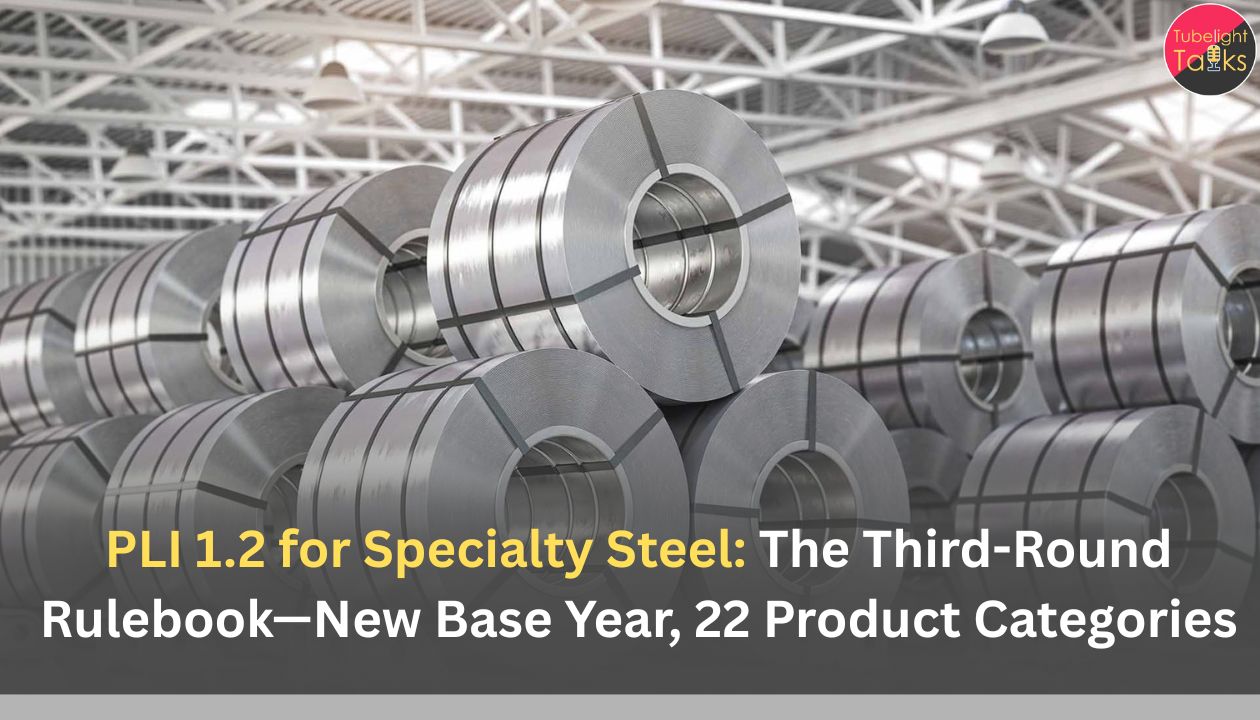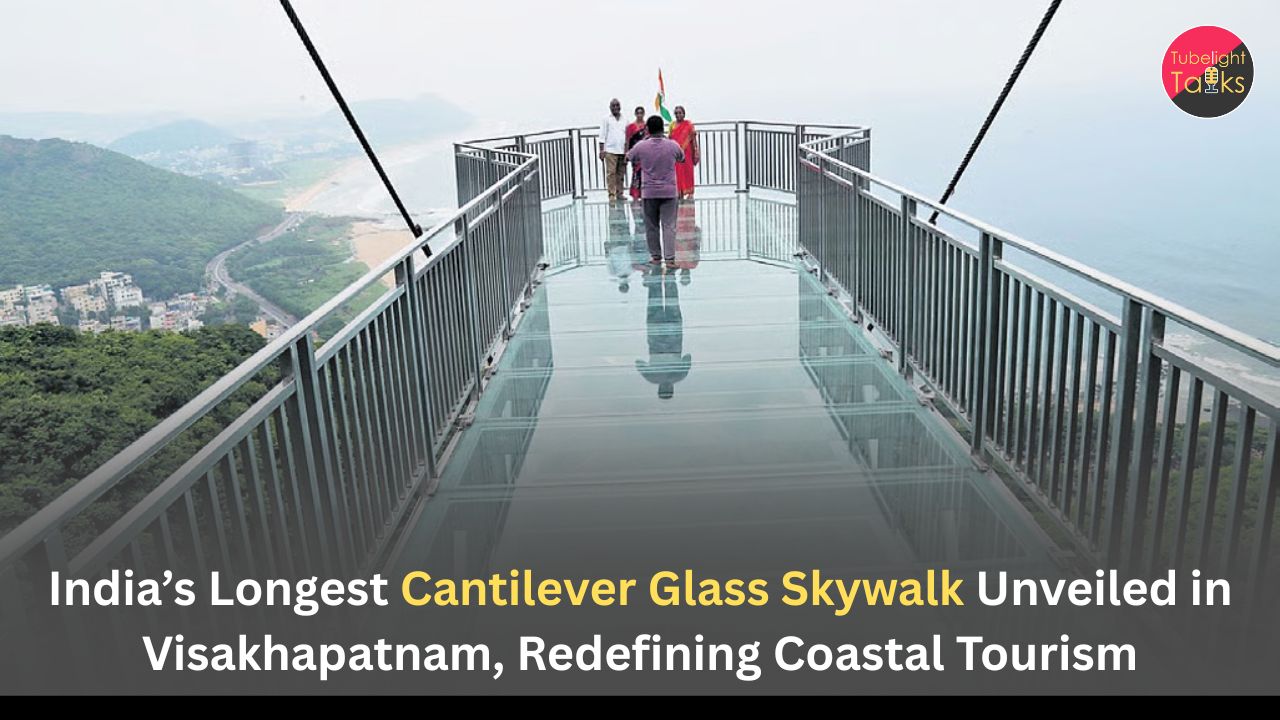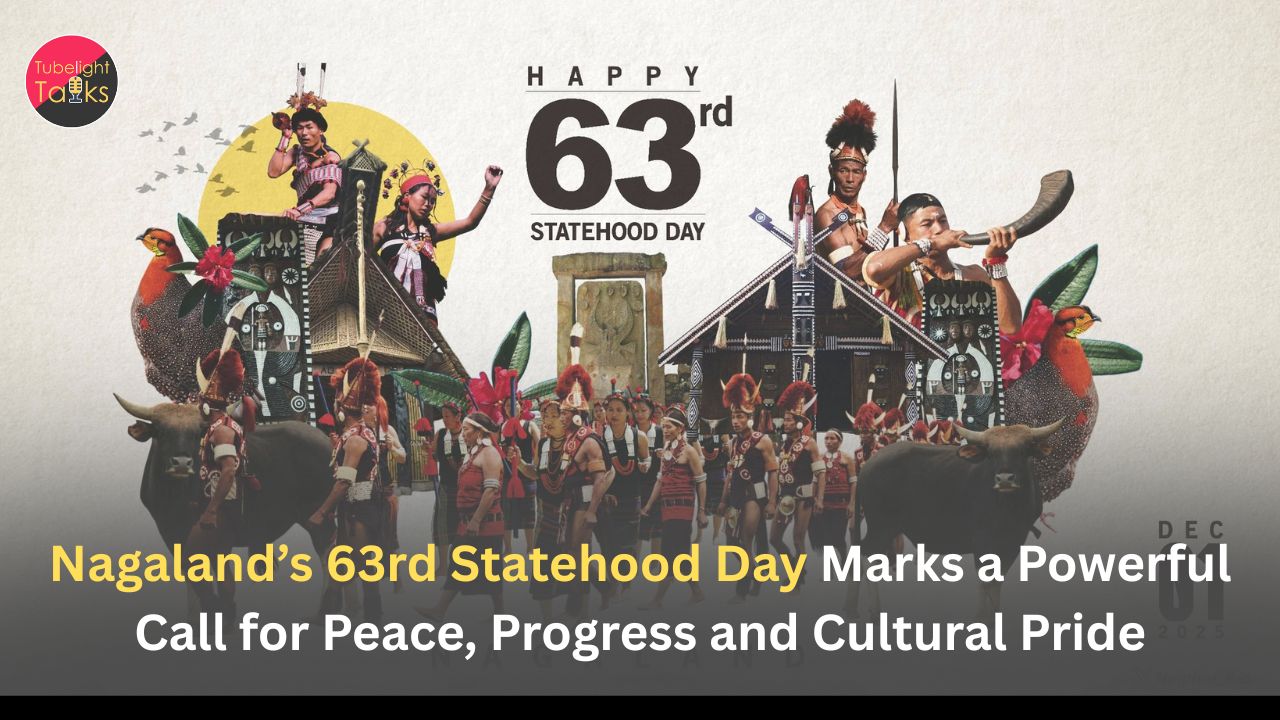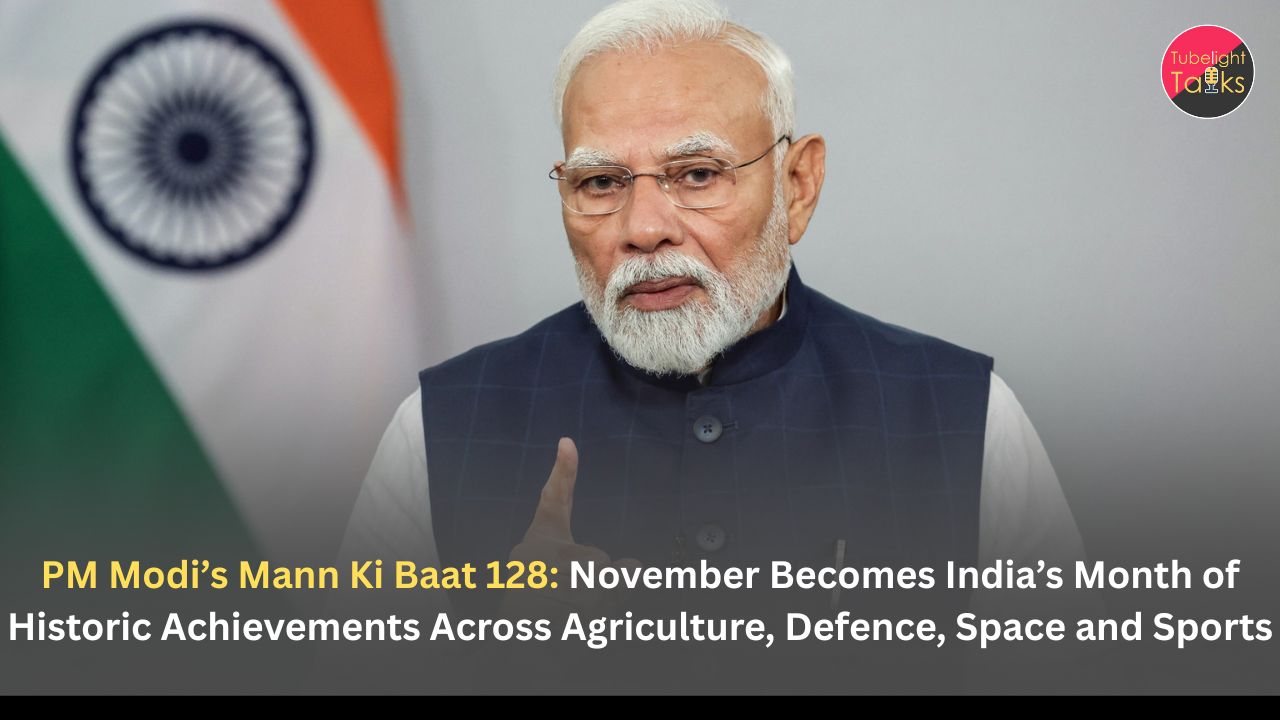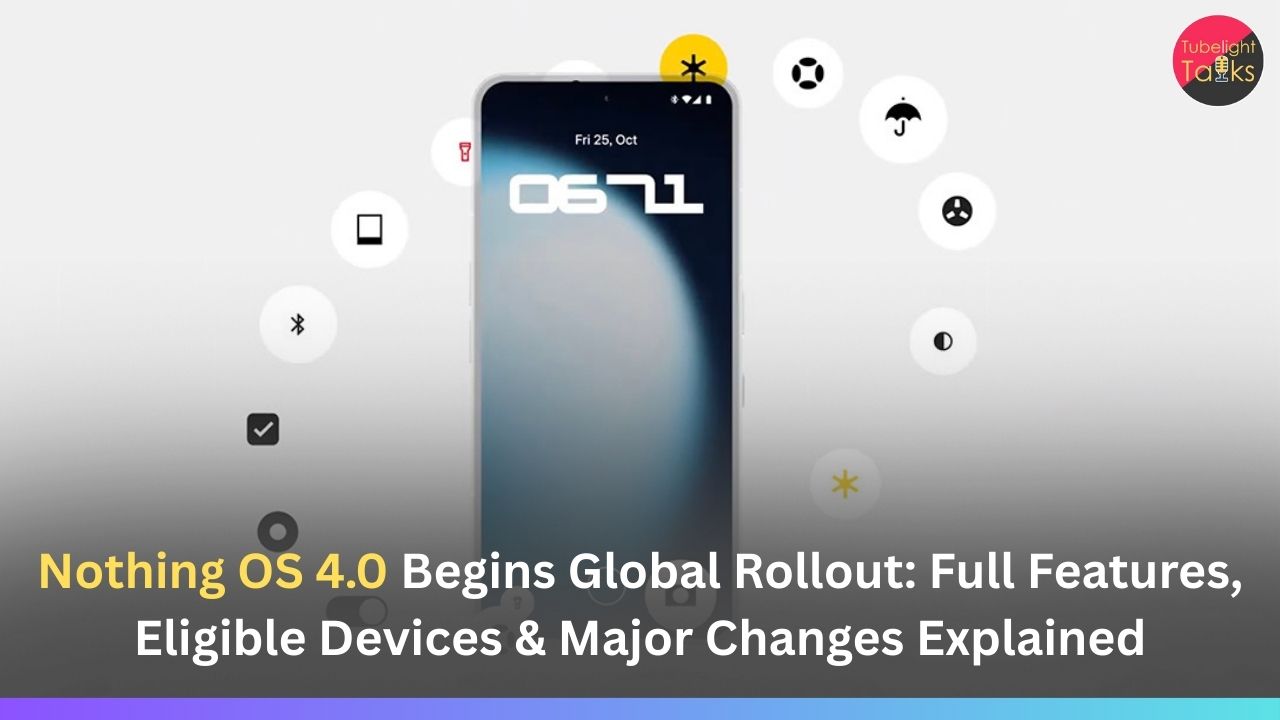PLI 1.2 for Specialty Steel: India has launched the third round of the Production Linked Incentive (PLI) scheme for specialty steel—“PLI 1.2”—to accelerate domestic manufacture of advanced grades critical to defence, aerospace, automobiles, energy and infrastructure. The round covers 22 product sub-categories, offers 4–15% incentives on incremental sales, resets the base year to FY 2024–25, and runs for five years with payouts beginning FY 2026–27.
Officials highlighted continuity with earlier rounds while easing entry for more players, including MSMEs. Below, we decode what’s new in PLI 1.2, how incentive calculations work, eligibility and thresholds, product coverage, timelines, documentation, and sector-wise opportunities—with official references.
What exactly is PLI 1.2 and why now
PLI 1.2 is the third round of India’s PLI scheme for specialty steel. It adds new product sub-categories and refreshes key parameters to reflect current market conditions and technology priorities. The Ministry of Steel says this round targets advanced and strategic steel grades and continues the government’s aim to localise value chains and cut imports in high-value segments.
The Ministry’s press releases confirm the 22 sub-categories, 4–15% incentive bands, and the FY 2024–25 base year, with a five-year accrual period starting FY 2025–26 and payouts from FY 2026–27.
“The third round (PLI 1.2) covers 22 product sub-categories… incentive rates range from 4% to 15%… base year updated to FY 2024–25… incentive period FY 2025–26 to FY 2029–30, with disbursal beginning FY 2026–27.”
Context from the earlier rounds
The specialty steel PLI was first notified in July 2021 with an overall outlay of ₹6,322 crore. Across the first two rounds, the Ministry reports ₹43,874 crore of committed investment and ₹22,973 crore already invested by September 2025, with 13,284 jobs created and 14.3 MT of projected specialty-steel capacity identified. PLI 1.2 builds on that pipeline while widening the product aperture.
Fresh budget and ambition signals
Media briefings around the launch put the new-round outlay at about ₹2,100 crore, and cite an investment ambition near ₹44,000 crore, aligning with the “supply the world from India” framing by the Steel Minister. Treat these as directional guides pending final project approvals.
What’s new in PLI 1.2 (Third Round)
1) Expanded product coverage—22 sub-categories
PLI 1.2 spans 22 sub-categories grouped under strategic and commercial families. Illustrative mentions in official notes include: super alloys, CRGO (electrical) steel, alloy forgings, stainless steel (long & flat), titanium alloys, and coated/wire products. The precise mapping appears in the detailed annexes; applicants should match HS codes/technical specs to the notified list.
2) Incentive range widened to 4–15% on incremental sales
Rates vary by sub-category and year. The top band recognises strategic grades with complex chemistries/processes, while commercial categories sit in the mid-to-lower bands. Incentive applies to incremental net sales over the FY24–25 base year, net of returns and taxes, subject to meeting annual thresholds.
3) Base year shifted to FY 2024–25
This resets the comparator from older baselines so industry performance is judged against a current price-volume context, a change particularly helpful for firms that expanded between 2019–24. Officially, the base-year update is flagged as part of encouraging wider participation.
4) Five-year accrual; payouts from FY 2026–27
Sales in FY 2025–26 through FY 2029–30 count toward accruals; disbursals begin the following year, enabling audited verification. This design mirrors PLI practice in other sectors and provides predictability for capex planning.
5) MSME on-ramps and threshold relaxations (policy intent)
Coverage notes and business reporting indicate relaxed entry thresholds and revised base-year logic to reflect market realities, aiming to broaden MSME participation (e.g., in coated/wire/stainless sub-categories and alloy forgings). Watch the official portal for exact threshold tables and documentation.
Who can apply: eligibility, documents, and governance
Applicant types
- Integrated steel producers adding/modernising lines for strategic/commercial grades.
- Downstream producers (stainless long/flat, coated/wire products) scaling specialty output.
- Forging houses & specialty alloy makers targeting aviation, defence, energy.
Confirm legal form, compliance history, and financial capacity per scheme guidelines (company/group/JV). Prior PLI materials outline one-sub-category-per-application logic; multiple lines require separate forms.
Key documents (indicative)
- Corporate/KYC basics; statutory auditor details.
- Plant location, utilities, environmental clearances (as applicable).
- Process & quality specs: chemistries, heat treatment, surface finish, NDT, standards (e.g., ASTM, AISI, IS).
- Capacity & ramp-up plan tied to the five-year accrual window.
- Sales projection worksheet with base-year reconciliation (FY24–25).
- End-use mapping (defence, EVs, renewables), supplier/customer MoUs where available. (Structure aligns with earlier PLI documentation styles.)
Governance and verification
The Ministry runs PLI 1.2 with evaluation committees and empanelled verifiers; audited sales and production data substantiate claims. Earlier specialty-steel PLI documents and annual reports describe the approach to thresholds, installed capacity, and incremental production checks.

Product families and opportunity mapping
Strategic grades (illustrative)
- Super alloys for high-temperature service (turbomachinery, space, defence).
- CRGO (electrical) steel for efficient transformers and grid upgrades.
- Titanium alloys for aerospace/defence and medical devices.
These command higher incentive bands (within the 4–15% range) given their import substitution and technological complexity.
Stainless steel (long & flat)
- Long: bars/wires for fasteners, shafts, and precision parts (auto, rail, chemical).
- Flat: sheets/plates for process equipment, appliances, F&B hygiene lines.
Incentives can fund AOD/VOD upgrades, continuous casting, and surface finishing improvements—critical to export competitiveness.
Coated & wire products
Galvanised, aluminised, pre-painted, and wire rod derivatives (springs, tyre bead, armouring). These enable downstream MSMEs to plug into auto, white goods, and T&D supply chains.
Alloy forgings
For power, oil & gas, aviation—demand requires stringent NADCAP/AS9100-aligned quality systems and NDT. PLI support can justify press upgrades, heat-treatment furnaces, and forging-microstructure control.
Incentive math—how to compute your accruals
The base
- Base year: FY 2024–25 (official). Reconcile sales records to this baseline.
The accrual
- Incremental sales = Eligible sales in a scheme year minus base-year sales for that sub-category.
- Apply notified rate (e.g., 10% within the 4–15% band) to the incremental amount to compute gross incentive.
- Ensure you meet minimum capacity thresholds and quality/standard checks per product sub-category (per guidelines tradition).
Timing of payout
- Accrual during FY 2025–26 to FY 2029–30; disbursal from FY 2026–27, post verification.
Example (illustrative only)
If your FY24–25 eligible sales = ₹300 crore; FY26–27 eligible sales = ₹420 crore; incremental = ₹120 crore. If your sub-category rate for that year = 10%, accrual ≈ ₹12 crore, subject to caps/conditions in the final notification.
What MSMEs should watch
Lower entry friction
Business reports underscore relaxed thresholds in this round, aligning with the new base year to allow more MSMEs into coated, wire, and stainless streams. Verify your exact threshold table once published on the Ministry/PLI portal.
Quality systems are non-negotiable
Strategic buyers require traceability, micro-cleanliness controls, and consistent mechanicals. Budget for spectrometers, inline surface inspection, heat-treatment controls, and lab certification if you’re moving up the value ladder.
Cluster strategies
- Auto components belts (Pune, NCR, Chennai) for stainless long/wire and coated lines.
- Transformer capital goods hubs for CRGO slitting/annealing.
- Aerospace/defence corridors (Nashik, Hyderabad, Bengaluru) for alloy forgings and super alloys.
Sector-wise impact: where the steel goes
EVs & clean energy
- Electrical steels to cut transformer/core losses for renewables integration.
- Stainless/advanced coatings for battery enclosures and power electronics housings.
PLI 1.2 can de-risk capex for dedicated lines serving grid expansion and EV supply chains.
Defence & aerospace
- Super alloys and titanium reduce import dependence for propulsion and airframes.
- Alloy forgings for critical rotating equipment. The incentive stack can anchor multi-year offtake with DPSUs/tiers.
Infrastructure & mobility
- Coated long/flat for corrosion resistance in coastal/industrial builds.
- Stainless long for rail/metro interiors and high-hygiene environments.
Timelines, application windows, and where to look
The launch was announced on November 4, 2025 in New Delhi. Post-launch, expect application windows, FAQs, and threshold annexes to be published on the Ministry/PLI page and disseminated via PIB. For historical context and how prior rounds were administered (including lists of approved applicants), refer to the PLI portal operated with MECON.
How PLI 1.2 fits into India’s steel-industrial strategy
PLI 1.2 complements the 2021 scheme outlay (₹6,322 crore) and seeks to crowd in private investment into high-value metallurgical processes that carry export potential and technology spillovers. The government’s own scorecard across PLI schemes shows momentum in investment and jobs; within specialty steel, the first two rounds have translated into billions in capex already invested.
Compliance & risk checklist (editor’s desk)
Before filing
- Map SKUs → HS codes to the notified sub-category.
- Reconcile FY24–25 sales cleanly; prepare auditor notes on accounting policies.
- Capacity plan aligns with five-year trajectory; include utilities & energy efficiency.
- ESG permits (where applicable) and capex EHS plan.
After approval
- Monthly production & QC reports; batch traceability; maintain labs/third-party test records.
- Sales documentation—POs, invoices, logistics proofs—to defend accruals.
- Variance analysis year-on-year against projections.
What to watch next
- Application window dates and threshold annexes.
- Final lists of approved applicants and progress dashboards (as in prior rounds).
- Alignment with defence procurement offsets, EV & grid programs, and export promotion.
Growth with Conscience
Industrial policy is ultimately about people: skilled jobs, safer equipment, cleaner energy, and fair opportunity for smaller manufacturers. Ethical guidance in public life often emphasises honesty, fairness and duty of care—principles that matter on the mill floor as much as in ministries. Sant Rampal Ji Maharaj Discourses widely available online encourage employers to treat workers with respect and employees to work truthfully, arguing that prosperity is most stable when it is righteous and inclusive.
For readers seeking this values lens on economic growth, see talks on ideal behaviour for employers and employees and the book “Way of Living”, which connects worldly duties to ethical conduct.
File Smart, Build Deep-Tech Steel
Anchor your bid to verifiable upgrades and export-grade quality
- Download the PIB launch notes and align your sub-category to the 22-item list; confirm your incentive band and FY24–25 base.
- Model the five-year ramp (FY26–30 sales) and show audit-ready reconciliation to base year.
- Lock customer pathways (DPSUs, auto, energy, appliances) and map standards.
- Budget quality infrastructure (metallurgy labs, NDT, annealing controls) and EHS.
- Submit on time once the application window opens and track clarifications on MSME thresholds.
Read Also: India’s Union Cabinet Approves Rs 7,798 Crore for Key Railway Projects and Space Sector Growth
FAQs: PLI 1.2
Q1. What’s new in PLI 1.2 versus earlier rounds?
A refreshed FY24–25 base year, 22 product sub-categories, 4–15% incentive bands, and a five-year accrual period with payouts from FY26–27.
Q2. What products are covered?
Official mentions include super alloys, CRGO, alloy forgings, stainless (long & flat), titanium alloys, and coated/wire products—see notified annex for full mapping.
Q3. How big is the new round?
Reports put the PLI 1.2 outlay around ₹2,100 crore and speak of ~₹44,000 crore fresh investment ambition; watch the Ministry for confirmed project-wise approvals.
Q4. When do incentives pay out?
Accrual begins FY 2025–26; disbursals start FY 2026–27 after verification.
Q5. Are MSMEs really encouraged this time?
The new base-year logic and reported threshold relaxations aim to broaden participation; check official threshold tables when published.
Q6. What’s the track record so far (earlier rounds)?
The Ministry cites ₹43,874 crore in commitments, ₹22,973 crore invested, 13,284 jobs, and 14.3 MT projected specialty-steel capacity under the first two rounds.






